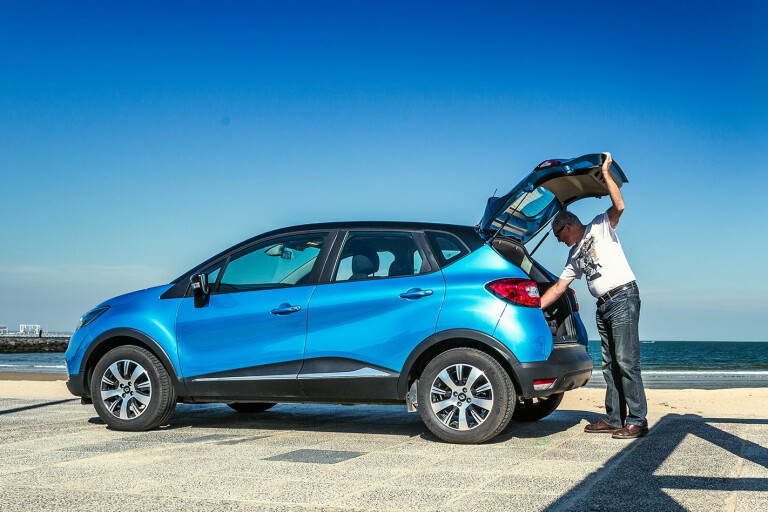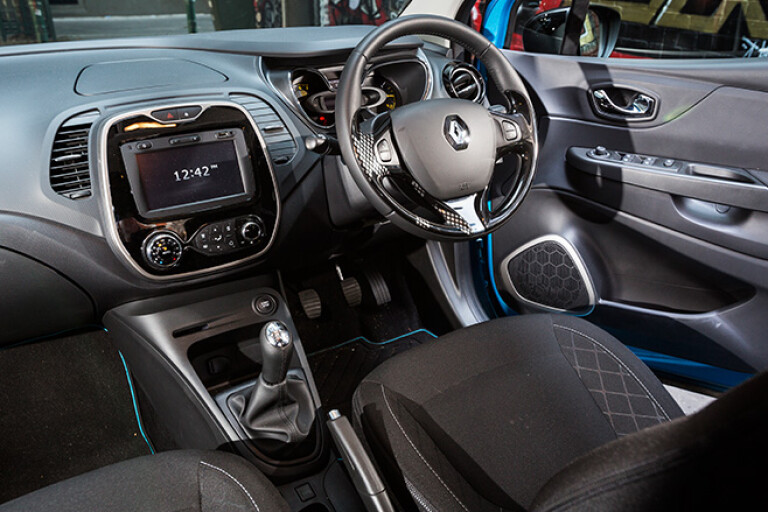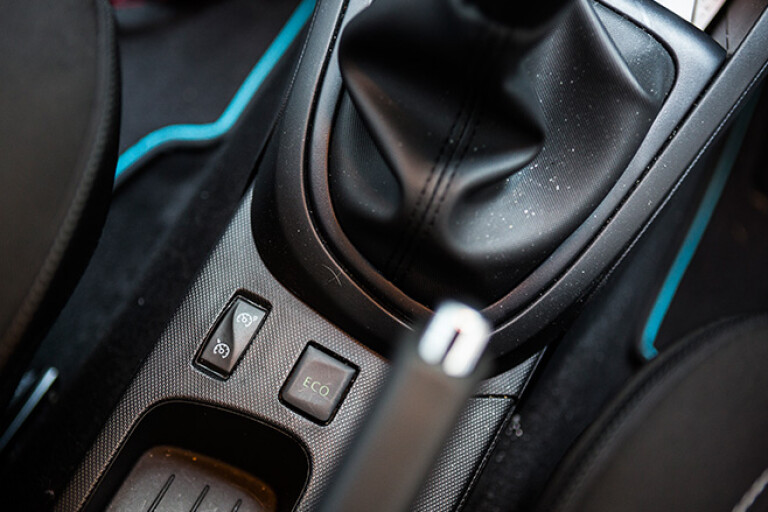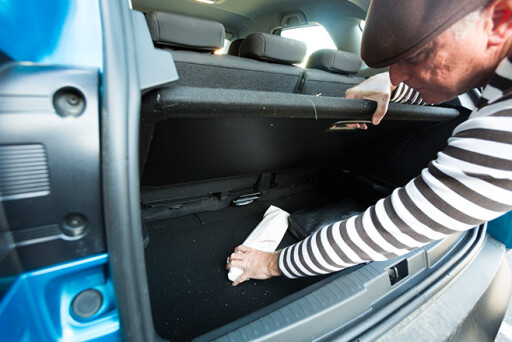
My one and only previous experience of a three-cylinder car was the rather obscure and curiously named Suzuki Mighty Boy back in the 1980s. And my abiding memory of that car – other than the fact it was incredibly impractical for a ute and incapable of carrying anything more than an attache case and a toothbrush – was that, while it sounded like a mighty flat-10 Porsche 917 hammering down the Mulsanne at Le Mans in 1970 as you snapped through the gears, it performed more like a strangled Beetle towing a horse float. It was certainly more boy than man, and not so mighty.
So it was with some trepidation that I approached my new long-termer, Renault’s frankly girl-friendly Captur mini-SUV with its 898cc triple, even though it does boast a turbocharger just like Porsche’s even mightier 917 Can-Am cars that revolutionised racing in the early 1970s.
Sure, I’d read and listened to the ravings of Ponch and Byron about their beloved turbo triples, but it wouldn’t be the first time I’ve been out of step with some of my colleagues over trends in motoring. Could such a pipsqueak engine really be all about “thrummy goodness”?

First impressions were not all good. As I drove away from Renault’s collection centre there was a reassuring thrum from the engine alright, just like that yellow Mighty Boy of old, but there was also a disconcerting lack of forward motion. As I racked up the first hundred kays getting used to my new environment, a deepening dread took over. The lack of performance was chronic; this car simply struggled to get out of its own way.
But then, enlightenment. An examination of the owner’s manual revealed a switch – inconveniently located down between the front seats, obscured by the handbrake – labelled ‘Eco’.
As you might imagine, this dulls the throttle and power output. Exactly why you’d want to do that to such a small engine I dare not imagine, but to my delight turning it off transformed the little Renault Captur. Suddenly that thrummy goodness was unleashed, revealing a surprising level of torque and response, at least above 2500rpm. This could be a happy association after all.
Best of all, the Eco switch remains off – as it surely will for our six months together – whenever I drive the car, so I don’t have to worry about resetting it every time I get in.

With fears about the Captur’s performance set aside, I was able to embrace its other charms more willingly. Though surely designed to appeal to women, I can appreciate the modern lines of the body, that already iconic Renault nose design, the funky chrome-embellished scallop shape in the side, the ‘floating’ roof in contrasting black to the mainly metallic blue paintwork. Some think the chrome highlights are overdone, notably the scoop surrounds in the front bumper, but I think they cleverly ground the car, making it look less tall than it is.
Also impressive is the interior’s presentation, which is not only comfortable but comparatively normal for a French car.
I’m not sure how I’ll go with Renault’s usual but still awkward audio controls hidden behind the steering wheel, but the wheel itself is pleasing – I even like the sporty chequer pattern, which makes the car feel a bit more masculine – the centre information pod looks and works well, the carbonfibre-look dash doesn’t come across as cheap (as it might have), all the controls feel solid and well-weighted, the seats are comfortable, and there’s no shortage of space for my 1.8-metre frame.
It’s no Mighty Boy, but boy the Captur could turn out to be mighty.
Update #2
I admit to being a Francophile. It’s a relationship that’s been tested over the years – nuclear testing in the Pacific comes to mind, and that pompous clown Jean-Marie Balestre who presided over the FIA in the 1980s – but nothing that a visit to Paris or the Loire Valley couldn’t overcome.
The French have an admirable outlook on life, an effortless elegance, a love of food and drink, a beautiful language and a remarkable creativity that is reflected in their architecture and movies.
But my love of things French has never extended to cars, even though that creativity has produced some of the most elegant designs in history, such as the Citroen DS. Also some of the most effective, from the incomparable Citroen 2CV to Peugeot’s iconic 205 GTi hot hatch. Perhaps I was scarred by having raced a French car – ah, yes, the mighty Renault 12 – but that’s another story.
I was nevertheless looking forward to getting my latest long-termer to see how I’d go living with a French filly. I’d happily spent a month driving a Koleos in France a few years ago, but that was on home soil. My new Renault Captur has to pass muster in Australian conditions, dealing with big open roads, not tootling around the back streets of Montmartre or cobblestone villages.
So far it’s been coping manfully, if you’ll excuse such a description for a car that is anything but macho. With a tiny little turbo three-cylinder engine that has to drag around 115kg more than the equivalent Clio on which it’s based, the Captur is hardly a ball of fire around town. I’m never going to win the Grand Prix du Traffic Lights, but by working the gears diligently and keeping the revs up, we can at least stay with the flow and not embarrass ourselves.

Another French trait is overly soft suspension and, while the Captur doesn’t bounce as much as my previous Jeep Cherokee, I’d prefer it to be more tightly controlled. And I’m glad the bewildering switchgear of old has succumbed to globalisation.
Having the indicators on the ‘wrong’ side was always a bugbear of mine, but it’s so common these days you adapt quickly and rarely hit the wipers by mistake, while the gearshift quality is now world standard, unlike years ago when it was like poking into a jar of molasses. Thankfully, I don’t have to worry about the notorious depreciation of French cars, and I’m yet to experience any reliability issues.
French cars are like art; not really my thing (at least not modern art, or Impressionism), but I like that they exist because they’re different and bring a fresh perspective that inspires others. Maybe I wouldn’t buy a Renault, but I’m glad other people do.
Update #3
Buying a new house can be one of the most exciting things you can do in life – or the most stressful, frustrating, annoying and downright distressing. As you can probably read between the lines, I have mixed feelings about the whole caper. And don’t even get me started about agents and how they’re largely responsible for Australia’s absurd affordability crisis.
Despite all that, I actually quite like the searching process. I love trawling the web, finding likely properties, drawing up a schedule of inspections and dragging the family around from one to the next with military precision. It’s quite exhausting, yet also thrilling and nerve-wracking all at once.
It’s also a good test of a car. There’s lots of stop-starting, piling in and out, parking in tricky places, negotiating unfamiliar territory, eating on the run, working the satellite navigation overtime and rushing to make up lost time because some people simply can’t assess a million-dollar purchase in the allotted 10 minutes. Anyone would think it’s potentially life-changing! Come on, people, we should be two suburbs away.
I thought the Renault Captur would be the perfect vehicle for such duties, being a commodious ‘SUV’ yet compact enough to be nippy. I was being optimistic.

The ‘kids’ lumped into the back seat are 20-somethings who know nothing of imperial measures yet are keenly aware of their “six foot-plus” stature, which challenges the Captur’s metric capacity. They’re too polite to complain, but when asked are happy to proffer that being wedged into the back doesn’t combine well with a jiggly ride and winding roads. Mum didn’t feel too settled in the front, either.
As it happens, we’re looking in The Dandenongs, the hills on the outskirts of Melbourne’s east, and there are plenty of twists and turns, dips and rises, sharp hairpins, bumpy dirt roads and sometimes daunting driveways. The traction control occasionally worked overtime as the tyres scrabbled for traction, yet somehow the blue Renault always made it back to the blacktop without anyone having to get out and push. But the poor little three-pot turbo did struggle with such a fullload and some fierce climbs.
Most annoying was the reversing camera. It’s not a sparkling display, so it wasn’t always easy to make out what was on the screen when presented with unmade roads, dirt verges, ditches, and sometimes even scary steep drops. Worse still, though, the damn screen takes about 12 seconds to come on after you’ve started the car and selected reverse. Why? I’ve no idea. But it’s a long time to sit in gear waiting for a screen to come on before you can start reversing.
At least the sat-nav worked a treat and could be programmed on the run. It certainly made communicating with the car easier than with the agents.
Update #4
Renault knows a thing or two about small turbocharged engines, though you would be forgiven for thinking otherwise if you’ve been following Daniel Ricciardo’s exploits in this year’s F1 world championship. The poor guy must go to bed some nights wondering if the Regie has ever built a decent engine in its life.
But Renault has not only produced some stunning Formula One engines – powering seven drivers to 11 world titles – it actually pioneered the turbocharged F1 engine.
In the late 1970s the French turned racing on its head by producing a winning 1.5-litre turbo V6, overcoming considerable teething problems; rival team chief Ken Tyrrell dubbed the cars the ‘yellow teapots’ because they were always on the boil…
Turbos were all the rage in the 80s, but it took the cool Swedes to harness the power and make them suitable for regular motoring. Turbocharged engines had been all about high boost and performance, and turbo road cars tended to be a bit wild, with sudden explosions of power that threatened to throw you off the road. Saab changed that in the early 90s with the ‘light pressure turbo’, which produced enormous low-rev torque rather than peaky power, and with less lag.

Here we are today, where turbos are as much about economy as performance. Now we have a car like the Renault Captur, which makes do with just 898cc of capacity to haul its mini-SUV arse around. It’s a hell of a feat.
However, the awe I feel for this technology is more theoretical than practical.
Truth is, 66kW and 135Nm simply doesn’t cut it. You won’t find many other cars struggling as hard as this to get up to speed – 13 seconds flat from rest to 100km/h for heaven’s sake – and it’s no better accelerating on the move, either. You have to work hard to keep up with the ‘Cardashians’.
I’d tried to stay positive about the three-pot Captur, thinking back to how Renault had decimated the V8s and 12s in F1 with an engine half their size, but what really did it in for me was taking a Mazda CX-3 home one night. The Mazda’s 2.0-litre atmo felt alive by comparison, responding quickly to my right foot as I happily zipped along with the traffic. In theory, the Mazda uses 25 percent more petrol, but in practice I reckon the difference would be much less that that – and the extra cost of the 95-octane juice required by the Renault means there’s no price to pay at all for that extra driving enjoyment. For me, it’s a no-brainer.
So I’ve put my inner Alain Prost on ice; now I’m listening instead to my inner Daniel Ricciardo.
Update #5
You wouldn’t think a cylinder the size of a snack-can of baked beans could be a real game-changer for something as big as a car. But enthusiasts know only too well there’s no replacement for displacement. It’s an easy way of gaining performance.
What’s not so easy is adding cylinders to existing engines. Cosworth put a couple of its four-cylinder engines together and created the legendary DFV V8 that dominated F1 racing for 20 years, while Volkswagen Group made a W12 by mating two V6s. In the same vein, Renault’s 1.2-litre four-cylinder turbo available for the Captur is essentially the 0.9-litre three-pot with an extra cylinder tacked on the end. My apologies to any engineers reading this…
After complaining last month about the slovenly progress of my blue long-termer, I was keen to try the four-cylinder version and Renault was equally happy to provide one for comparison. So for the past few weeks I’ve been driving a Renault Captur Dynamique variant that not only has the bigger engine, but also a dual-clutch transmission because it’s not available with a manual. And, because it’s an auto, it goes without the idle-stop function. As far as I’m concerned that’s a win-win-win.

The extra grunt transforms the car, making it a delight to drive; you can comfortably keep up with traffic, accelerate up hills that stump the three-cylinder, and not have to worry about falling off the power brand and losing all momentum. What’s more, the four-pot does it much more quietly, so it’s less wearing on driver and passengers alike.
In line with the capacity, outputs are similarly up about a third and, importantly, it comes on strong earlier than the three-pot engine. Power goes up from 66kW at 5250rpm to 88kW at 4900rpm, while torque increases from 135Nm at 2500rpm to 190Nm at 2000rpm. Okay, it’s no DFV, but these are significant numbers in context.
Despite carrying an extra 81kg, the bigger engine slashes 2.1sec off the sprint to 100km/h. And that extra weight seems to benefit the Captur’s ride, making it settle better and feel less choppy. Even the fuel consumption is a match – 7.0L/100km on a few tanks versus a four-month average of 6.8 for our three-cylinder.
Less impressive is the Getrag six-speed dual-clutch transmission, which might shift quickly and smoothly once on the move, but is slow on take-off and a bit dithery around town, unsure whether to pre-select first or third when you’re in heavy traffic toddling along in second.
But I don’t care. More power, better flexibility, quieter operation, comparable fuel use, no confounded idle-stop and the convenience of an automatic. For the sake of a few grand, you can keep your thrummy triples.
Farewell
At the risk of revealing too much about my inner self, sometimes I wish I was a girl. They might think it’s a man’s world, but I reckon they have it made, or at least they did until they went down the road of equality and discovered it perhaps wasn’t everything they’d expected.
When it comes to cars, it seems that looks and colour are often the major factors women consider when choosing a new vehicle. Yes, I realise I’m generalising horribly here and owe an apology to the many female revheads reading this, but seriously, how many times have we blokes poured through mountains of research only for our better halves to decide they want a particular model because “it’s just so cute” or that it doesn’t matter “so long as it’s that bright metallic red”.
When I collected the Renault Captur back in March, I was well aware that this was a ‘chick car’ and certainly not intended for an ageing boy racer. So I tried to get in touch with my inner female. Not very successfully, as it turns out. I just couldn’t master the high heels and all that makeup palaver. But wearing a bra was kinda fun.

Sliding back seat and configurable false boot floor made carrying loads of varying sizes a breeze.
I digress. The point is that I had to get into an extremely atypical character to appreciate this car, and on the odd occasion I succeeded it wasn’t hard to see the appeal of that funky styling, the bright blue duco with floating black roof, the scalloped sides with black and silver swishes, the high seating position and extra headroom, the jazzy interior with its fancy seat covers and steering wheel, and the flexible boot space with a false floor that could be angled so your shopping didn’t go everywhere. Yep, it was fun pretending to be a girl.
But still it didn’t work for me. The technically impressive yet mere 898cc three-cylinder engine, even with the help of a turbocharger, just couldn’t get the job done adequately, and it only comes with a manual gearbox. Seriously, since when do us chicks do manuals?
I really wanted to see what the Captur was like with the bigger four-cylinder turbo engine and an automatic transmission, so I grabbed one for a few weeks and my opinion changed completely. Of course I knew the 1.2-litre would have better performance, but I didn’t expect it to change my perspective completely. Suddenly I began to appreciate its Gallic charms, which had been hidden behind expletive-riddled frustration as I tried to get the turbo triple to at least keep up with traffic flow. Now that was a given, and suddenly the minor foibles of the Captur – the hidden remote audio controls, the ’80s-style trip computer readouts, the cruise control switch down with the handbrake, the dodgy iPod connection – became what French car tragics would call character. And I didn’t mind it a bit. In fact, I asked to keep it a bit longer. Sacre bleu!
I’m also heartened that Renault’s globalisation has resulted in impressive build quality and, in the case of ‘my’ Captur, zero reliability issues. Not a fault, failure or even a single rattle during six months together. Perhaps that will come to be reflected in improved resale values in the years to come.
If I was a female – a proper one, not one of the Caitlyn Jenner variety – I think I could be drawn to the Renault. But like probably 99 percent of Captur buyers, I’d order the equally economical four-cylinder with the auto. Ca va?
COMMENTS